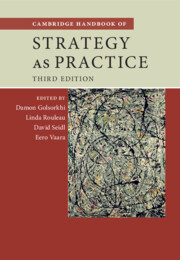Book contents
- Cambridge Handbook of Strategy as Practice
- Cambridge Handbook of Strategy as Practice
- Copyright page
- Contents
- Figures
- Tables
- Boxes
- Contributors
- Preface to the Third Edition
- Introduction: What Is Strategy as Practice?
- Part I Ontological and Epistemological Questions
- Part II Theoretical Resources: Social Theory
- Part III Theoretical Resources: Organization and Management Theories
- Part IV Methodological Resources
- Chapter 26 Using Ethnography in Strategy-as-Practice Research
- Chapter 27 Action Research as an Impactful Approach to Study Strategy with Practice
- Chapter 28 Studying Strategizing through Biographical Interviews or Narratives of Practices
- Chapter 29 Using Photographic Methods in Strategy-as-Practice Research
- Chapter 30 A Critical Discursive Approach to Strategy-as-Practice Research
- Chapter 31 Studying Strategy as Practice through Historical Methods
- Chapter 32 Quantitative Methods in Strategy-as-Practice Research
- Part V Substantive Topic Areas
- Index
- References
Chapter 29 - Using Photographic Methods in Strategy-as-Practice Research
from Part IV - Methodological Resources
Published online by Cambridge University Press: 11 March 2025
- Cambridge Handbook of Strategy as Practice
- Cambridge Handbook of Strategy as Practice
- Copyright page
- Contents
- Figures
- Tables
- Boxes
- Contributors
- Preface to the Third Edition
- Introduction: What Is Strategy as Practice?
- Part I Ontological and Epistemological Questions
- Part II Theoretical Resources: Social Theory
- Part III Theoretical Resources: Organization and Management Theories
- Part IV Methodological Resources
- Chapter 26 Using Ethnography in Strategy-as-Practice Research
- Chapter 27 Action Research as an Impactful Approach to Study Strategy with Practice
- Chapter 28 Studying Strategizing through Biographical Interviews or Narratives of Practices
- Chapter 29 Using Photographic Methods in Strategy-as-Practice Research
- Chapter 30 A Critical Discursive Approach to Strategy-as-Practice Research
- Chapter 31 Studying Strategy as Practice through Historical Methods
- Chapter 32 Quantitative Methods in Strategy-as-Practice Research
- Part V Substantive Topic Areas
- Index
- References
Summary
Anne Smith, Ace Beorchia, and Jaewoo Jung respond to calls for more innovative methods in SAP research by elaborating on the foundations of photographic methods and exploring their relevance for the study of strategizing activities and practices. The authors begin by discussing the increasing interest in visuals in management and organizational research and explain why photographic methods provide unique benefits for advancing strategy as practice research. They then review the use of photography in SAP research – identifying and discussing six SAP research projects in which photographs played a prominent role. Next, they develop and explain a framework to categorize the use of photography in strategy as practice research. Considering two dimensions – the photographs’ creators and the photographs’ role in research – this framework identifies four ways photographs can be used in a research project: outside-in supportive approach, outside-in integrated approach, inside-out supportive approach, and inside-in integrative approach. Based on this framework, the authors highlight the main considerations when undertaking systematic analysis of photographic data. To illustrate how SAP research can benefit from using photographs, they provide an example from longitudinal research studying how daily activities and changes to space are connected to strategic changes and provide a structured analysis of one photo image set extracted from this research project. They conclude by discussing different options in pursuing photographic methods in SAP research.
- Type
- Chapter
- Information
- Cambridge Handbook of Strategy as Practice , pp. 526 - 540Publisher: Cambridge University PressPrint publication year: 2025

